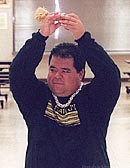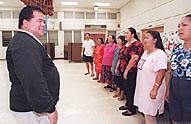| "They say teaching is a calling," says Kalani Akana, Interim Vice Principal of Waiau Elementary School. "Hawaiian immersion is even more of a calling. ... It’s a calling because if we don’t take charge now and do our best, we’re going to lose the language, I don’t want future generations to say, ‘You didn’t do anything.’ "
Eugene Tanner • The Honolulu Advertiser |
 |
By Vicki Viotti
Advertiser Staff Writer
On a shelf in Kalani Akana’s office, a row of pictures serves as his touchstone, a reminder of why he entered this teaching profession. The kids in the pictures call now and then.
"This was the first class," he said, pointing to one photo of 10 smiling youths who once ran through the halls of Waiau Elementary School and studied the Hawaiian language. "Now they call me ‘Uncle,’ which is frightening."
Akana is single and has no children of his own, but, in effect, his students are his children and he seems to have been born to teach. At the moment, however, he has veered a little off course. Call it a vocational detour.
Better yet, call it a pit stop, a pause for refueling, something that may speed his way to the finish line.
That, in Akana’s view, means the advancement of Hawaiian-language education.
 |
| Students chant for their kumu Kalani Akana in a Hawaiian language class at Waiau Elementary School.
Eugene Tanner • The Honolulu Advertiser |
After a dozen years teaching Waiau children entirely in Hawaiian through the state’s "immersion" program, Akana on Jan. 21 donned the mantle of school vice principal, whose attention must turn to brass-tacks disciplinary issues. He picked up a note from his desk, a parental complaint about a student’s treatment.
"We have come full circle," he said. "The parent believes the child first . . . it’s very adversarial."
When you’re 43 and raised under a completely different set of rules, this can be hard to take. Not that this robust vice principal has to take too much of it in person.
"Rarely will a parent come in to see me," he said, and then laughed. "I think I intimidate them. Maybe it’s my size."
The promotion is a temporary assignment, one he took to help his principal fill a difficult slot ("Who wants to be an administrator these days?") when the campus No. 2 went on leave for a semester.
He also hopes the experience will train him for a new role in immersion education (which in Hawai‘i means that all students’ subjects are taught in Hawaiian and only Hawaiian is spoken in class).
Akana only accepted the vice-principal’s job once a replacement immersion teacher was found. And, he said, "I made it very clear I was only interested in being an administrator for an immersion school," he said.
Teaching hula
That about covers his aspirations for his 9-to-5 job, but Hawaiian culture occupies his thoughts most of the day’s remaining hours as well. After a couple of decades as a dancer and chanter, Akana is a kumu hula and president of a nonprofit organization centered on the continuity of Hawaiian tradition.
The nonprofit Halau Haloa, was founded two years ago to organize and finance a delegation that represented Hawai’i at the Pacific Arts Festival, an event held every four years. The most recent version convened in New Caledonia in October. It was a kind of homecoming for Akana, who 20 years earlier had joined the first Hawai‘i festival delegation as a dancer.
Those glimpses of other cultures have bound him more firmly to his own, giving him a self-identity as part of the Pacific peoples. Lost nationhood for Hawaiians has eroded their consciousness about the value of their heritage, he said: Witness what has happened with the arts and crafts of Hawai‘i. Artistic methods and designs of the Islands have been appropriated by others without recognition of indigenous copyright and trademark.
Workshops on such issues have been held elsewhere in the Pacific; one of the aims of the halau is to see that Hawai‘i is a participant in such learning opportunities, said Akana, who feels especially strongly about the property-rights issue.
"Take the Hawaiian quilt," he said. "They’re being imported from the Philippines and Taiwan. Go to Costco. You can buy one for $900."
Another Halau Haloa mission, he said, is to promote the perpetuation of the truly traditional hula practices, those dances and chants handed down unchanged from one kumu to the next in each hula school.
"There’s not a lot of this kind of hula, not a lot of these teachers," he said. "There are neotraditionalists who think if there’s a hula you like, you do it. There’s no tradition you need to pass on. To many people . . . (tradition is) boring."
Akana’s colleagues speak admiringly of his efforts to balance contemporary concerns with a stewardship for Hawaiian legacies.
"He’s trying to include many of the kupuna and tradition, but he’s trying to make it work in the 21st century," said Paulie Jennings, a member of the halau board of directors.
More teachers needed
Akana believes that at the heart of cultural perpetuation is language. The youngest child of the youngest child of Hawaiian-speaking grandparents, Akana had little time to spend with these elders and missed language instruction from their hands.
Instead he studied as a teen, first pursuing hula as his own route to understanding his culture.
"It was either going to be hula or canoe paddling," he said with a chuckle. "I probably should have chosen paddling, because then I’d be 200 pounds lighter."
At 19, Akana began formal hula training under Kaha‘i Topolinski, whose halau Ka Pa Hula Hawai‘i joined the delegation to the arts festival last fall. Topolinksi, who now often consults his former student about Hawaiian chants, remembers being impressed by how well the young dancer grasped all the concerns the Hawaiian cultural renaissance brought to light, from the revival of the language to debates over political sovereignty.
Yet Akana is not a combative personality, Topolinski said.
"He did not take himself too seriously; he took the work seriously," he said. "He’s not swayed by detractors within the Hawaiian community. He just continues to develop his work, to come through with what’s expected.
"He’s very passionate. My kumu told me I will attract only people who are passionate like I am . . . he would have had to have those seeds within him for me to cultivate them," Topolinski said.
Akana began as an educator by helping to manage the kupuna program, in which elders come into schools to offer Hawaiian cultural instruction. But it’s the notion of immersing the children in the language that has captured his imagination. Akana wants to see a second O‘ahu immersion high school built — ünuenue is bursting at the seams, he said.
But there’s a need for more trained teachers, he said, and Akana has participated in initiatives to develop accredited teacher training for the immersion program.
He will admit that Hawai‘i has come a long way from the days when he began teaching without texts, without lesson plans. His first day at Waiau, he had no classroom.
"Every night I would stay up translating math lessons, preparing something for the kids to read, and anything else I could find," he recalled. "Every teacher was like that. We still lack, but they have things there now."
But things haven’t gone far enough, from his perspective. There remains plenty for Akana to do when, starting in the fall, he returns to the classroom.
"They say teaching is a calling," he said. "Hawaiian immersion is even more of a calling. I kind of feel chosen.
"It’s a calling because if we don’t take charge now and do our best, we’re going to lose the language," he added. "I don’t want future generations to say, ‘You didn’t do anything.’ "
[back to top] |

 The Great Index to Fun
The Great Index to Fun
